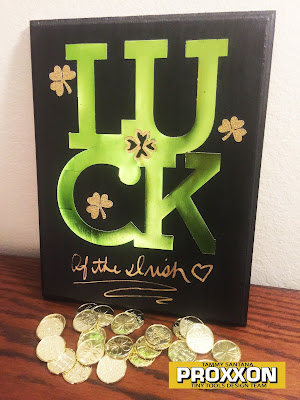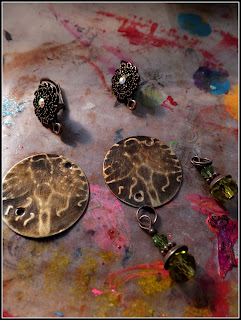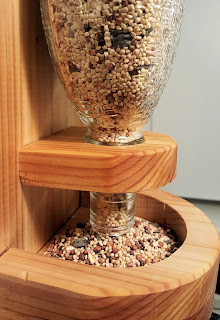I'm having a blast preparing for spring and making birdhouses and bird feeders for our yard. In my most recent Proxxon posts, I built an
Up-Cycled Wine Bottle Bird Feeder and a
Mid Century Modern Bird House.
Today we're building a fruit feeder using a scrap of lumber and an empty soda can. Baltimore Orioles, Brown Thrashers, Bullock's Orioles, Catbirds, Hooded Orioles, Mockingbirds, Red-bellied Woodpeckers, Rose-breasted Grosbeaks, Scarlet Tanagers, and Western Tanagers all love orange halves and this feeder is a great way to serve them up.
Be aware that attracting fruit-eating birds
can take time and patience. If
you have mature fruit trees
or bushes, or if you have seen
fruit-eating birds in your yard
or nearby, you will more
readily attract fruit-eaters. And, Mockingbirds can be territorial, so fruit
feeders may need to be placed away from
other feeders. With those tips in mind, let's get started.
The Pattern/Measurements
Rough Cedar 1x6 is about 5.5" wide. For this project, you'll only need a piece about 6" long. Start by marking out all the center lines on your scrap. The goal is to cut the biggest circle possible out of the scrap (in this case, 5.5" in diameter because it's limited by the width of the lumber) and to cut out a hole in the center big enough to hold an orange (about 3-4" in diameter). You'll need horizontal holes through the center of the circles to hold the skewer, which holds the fruit. A small hole at the bottom lets you put a dowel through the piece to use as a perch on both sides of the fruit.
For my geeky friends, here are the facts and the math. A standard soda can in the US is 4.83" high, 2.13" in diameter at the lid, and 2.60" in diameter (D) at the widest point of the body. If you cut off the top and bottom to make it 4 inches high, and cut down the side, you’ll have a piece about 4” x 8.17”. Remember, the circumference of a circle is
2πR or
πD. Pi or
π is about 3.14159. So, 3.14159 x 2.6" = 8.17"
The circumference of our feeder, a 5.5” diameter circle, is 17.28”. That means half way around the circle is about 8.64”. So, we only need a a strip from the can about 5-6” and we've got about 8" long. Trim it down and it will work perfectly!
Of course, you don't worry about doing the math. Just wrap a tape measure around whatever can you have and you'll see how long a piece of aluminum you can get out of it.
This diagram shows the lines you should draw and the plans for the feeder.
What You'll Need
Steps To Follow
1) Use the ruler, square and pencil to mark the center lines on the smooth side of the rough cedar. Using the compass, draw the two circles. Mark the hole for the perch. It should be along the vertical center of the two circles and centered between the 3" and 5.5" circles, as shown in the illustration above.
2) Create 3" in diameter hole in the center.
3) Use the
Proxxon Bench Drill Press TBM 115 to drill a hole through the piece. Be sure the hole is big enough to fit your dowel.
4) Use a Proxxon Rotary Tool with a small drill bit (e.g., 9/64) to drill a hole in each side of the "donut" to slide the skewer through. Be sure you drill deep enough to go in to the inner circle you drew. We're drilling these holes now because it's much easier to handle the piece while it's a square (compared to after you cut the outer circle and make the "donut.")
5) Cut out the outer circle using the Proxxon MICRO Bandsaw MBS/E. When you're cutting large curves, be sure to cut "relief cuts" around the curve. These allow waste pieces to fall away as your cutting, making it easier to follow a long curve. When you're done, you should have a "donut" shape.
6) Sanding around the "donut" with the
Proxxon Disc Sander TG 125/E makes it easy to smooth the edges.
7) Test to make sure the dowel and the skewer fit and make any necessary adjustments.


8) Once your confident everything fits, put a little wood glue in to the hole for the perch and insert the dowel through. Wipe the part of the dowel you pushed through clean of any glue residue.
Do not glue the skewer in place. You have to be able to slide that in/out to fill the feeder.
9) Seal and protect all parts of the feeder with linseed oil. Rub it in using a cotton cloth (rag). Let it dry completely. While it's drying, you can work on the aluminum roof.
10) Use tin snips to cut off the top and bottom of the can (make finished piece about 4" tall). Then snip up the side of the cylinder. Then trim the length of the strip to about 5-6" long.
11) If you don't want the soda can label to show on your feeder, use a piece of steel wool to burnish it off. This is easiest if you're working under a small stream of water, like in your sink.Remember, the aluminum is sharp, so be careful! You might want to wear heavy gloves while you're doing this, to be safe.


12) Use a corner rounder punch or the snips to round the corners of the rectangle. This will also help sharpen your punch!
13) Find the center of the aluminum rectangle and line it up with the center top of the "donut." Use the staple gun to attach the rounded rectangle around the top half of the "donut." This makes the roof of the feeder.
14) Drill a small pilot hole at the top of the "donut" (through the aluminum roof and in to the wood). Insert the screw eye.
15) Cut an orange in half and use the skewer to hold it in the center of the "donut," hang your feeder and patiently wait for fruit-loving birds to arrive! Dinner is served! Bon Appétit
Happy Crafting!
Joe
www.createNcraft.com




































































